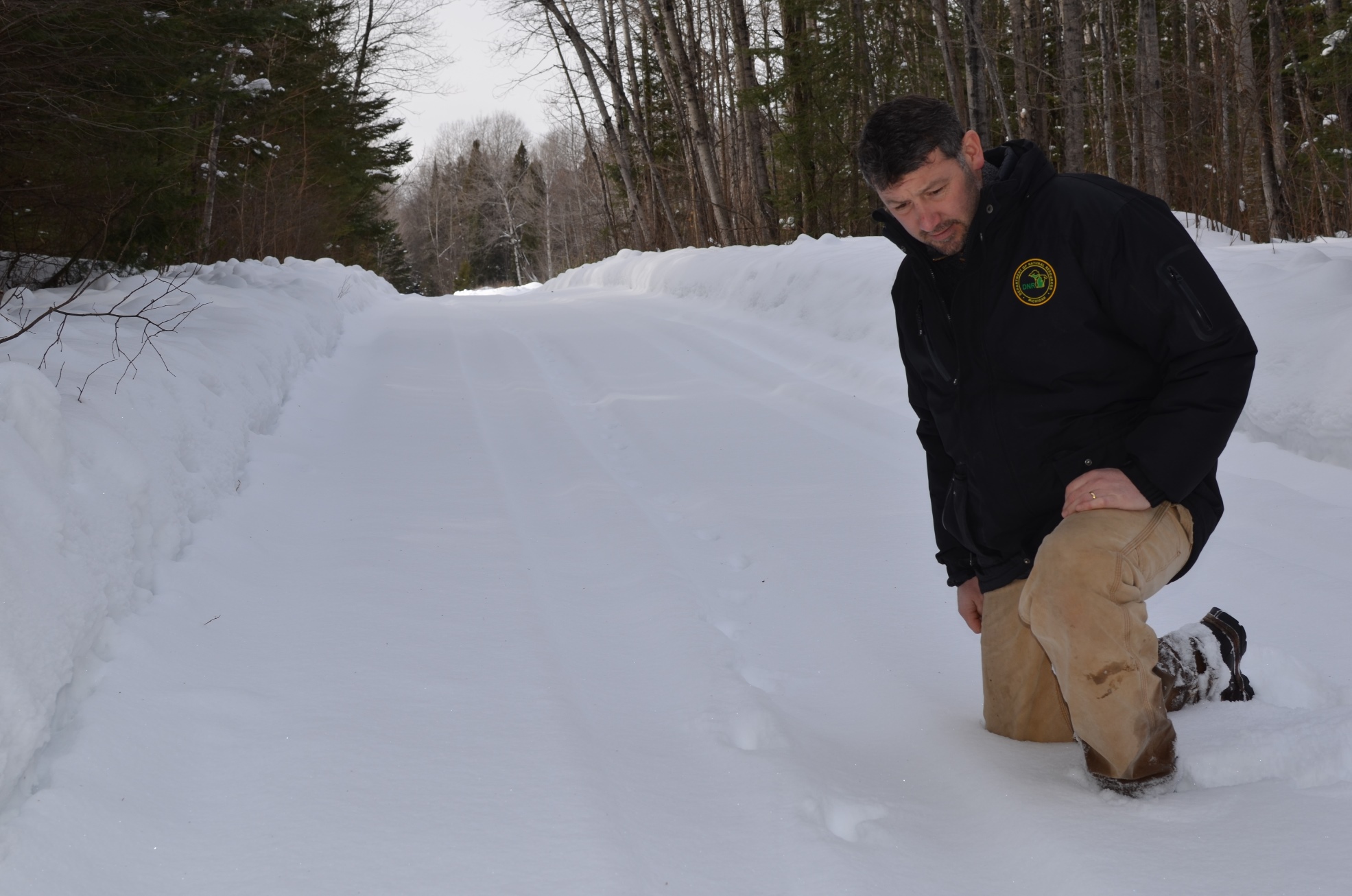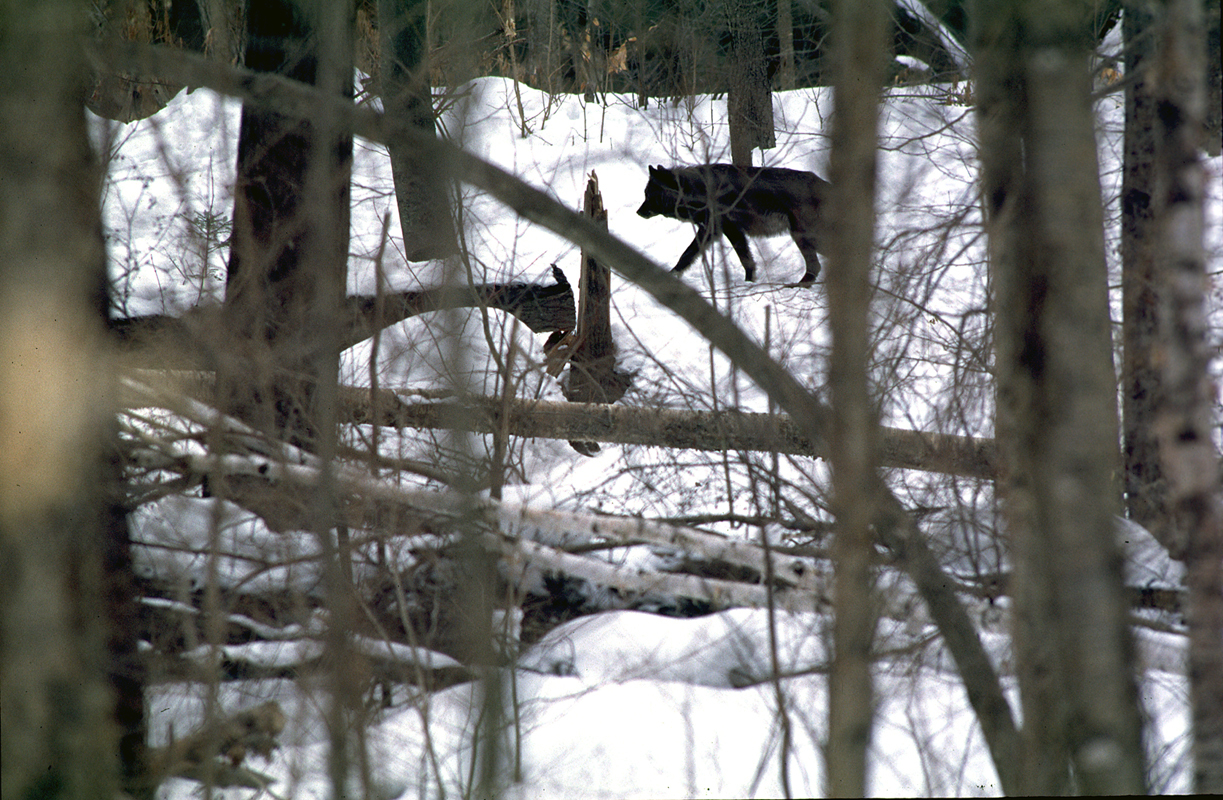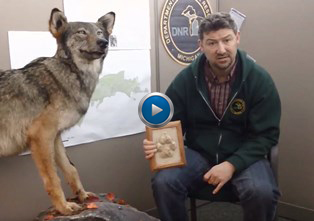|
This is a bonus "Showcasing the DNR" story, in addition to our regular weekly Showcasing distribution that comes out each Thursday. We hope our subscribers find it interesting!
Biologists conducting U.P. wolf survey, DNR supporting efforts to return wolf management to Michigan
On a snow-swept back road in Delta County, a Michigan Department of Natural Resources wildlife biologist drives his vehicle slowly. Watching out his windows, he scans each set of animal tracks he sees pushed into the fresh snow.
Among the footprints left by bobcats, white-tailed deer, snowshoe hare and other animals, he’s looking for the large-pawed tracks of gray wolves, laid out in a path down the road or into the woods.
Discovering wolf tracks – and then following them for long distances – helps biologists estimate population size and delineate where, and how, wolf packs are spending their time this winter.
Population dynamics
Originally native to Michigan, wolves had all but vanished from the Upper Peninsula – not including Isle Royale – by the early 1960s. This occurred through hunter bounties and as white-tailed deer populations declined.
 Michigan protected wolves as endangered species in 1965. Federal protections were solidified under the Endangered Species Act of 1973. Michigan protected wolves as endangered species in 1965. Federal protections were solidified under the Endangered Species Act of 1973.
As neighboring Wisconsin’s wolf population began to rebound during the 1970s, reports of lone wolf sightings increased in the U.P. Biologists confirmed a pair of wolves in the central U.P. in the late 1980s, a union that produced pups in 1991.
Since the winter of 1993-94, combined wolf numbers in Michigan and Wisconsin have surpassed 100, meeting federally established goals for population recovery. The Michigan goal of a minimum sustainable population of 200 wolves for five consecutive years also was achieved.
From 1994 to 2003, the U.P. wolf population saw an average annual growth rate of 19 percent. Growth shrunk to 12 percent as the wolf population neared the maximum level the U.P. could sustain – the biological carrying capacity.
Since 2011, wolf population estimates have not changed significantly. The DNR’s most recent minimum estimate of the U.P. wolf population was 636, issued in spring 2014.
A new DNR wolf survey began in December. No preliminary results are available yet, but a new minimum population estimate is expected in April.
Biologists are surveying wolf populations in some areas and extrapolating that data to estimate the number of wolves across the region.
“As we’ve done over the past few years, to reduce staff effort and expense, a stratified sampling method is being used to carry out the survey throughout the Upper Peninsula,” said Kevin Swanson, a wildlife management specialist with the DNR’s bear and wolf program. “We are now more than halfway through that survey period.”
During February, survey biologists began looking for signs of breeding exhibited by scent marking and blood in urine, which indicates a female wolf may be in estrus (heat).
“Based on the wolf sign I am finding while searching for packs in central and southern Marquette County, northern Menominee and northern Delta counties, I do not anticipate any drastic fluctuations in wolf abundance in that particular area,” Swanson said. “But results may vary significantly in other parts of the U.P.”
The migration of deer from the northern to the southern parts of the U.P. was postponed by several weeks this winter, which has been comparatively milder than the past three. winter, which has been comparatively milder than the past three.
“The delayed deer migration is now over in many areas so we will focus more of our survey efforts in deer yarding complexes, places where wolves frequent to prey on deer,” Swanson said.
In the Lower Peninsula, over the past few years, there have been persistent reports of sightings, tracks and other evidence of wolves.
In March 2014, biologists with the Little Traverse Band of Odawa Indians discovered tracks and collected scat from what was presumed to be a wolf in Emmet County. DNR biologists also visited the site.
In September 2015, confirmation was received from Trent University in Peterborough, Ontario, that the Emmet County scat submitted for DNR analysis was from a male gray wolf. This marked the second confirmation of wolf presence in the Lower Peninsula since 1910. The first occurred in 2004 when a wolf collared by the DNR in Mackinac County was caught and accidentally killed by a coyote trapper in Presque Isle County.
The DNR’s ongoing wolf track surveys are conducted only in the U.P. Wolf reports in the Lower Peninsula continue to be investigated.
Legal challenges
In January 2012, citing wolf recovery in the region, the U.S. Fish and Wildlife Service took gray wolves off the federal endangered species list in Michigan and Wisconsin and the threatened species list in Minnesota.
"Gray wolves are thriving in the Great Lakes region, and their successful recovery is a testament to the hard
work of the Service and our state and local partners," Fish and Wildlife Service Director Dan Ashe said at the time. "We are confident state and tribal wildlife managers in Michigan, Minnesota and Wisconsin will effectively manage healthy wolf populations now that federal protection is no longer needed."
The ruling allowed Michigan, Minnesota and Wisconsin to manage wolves according to their wolf management plans. Michigan’s plan was crafted with the help of a panel representing a wide span of interests ranging from Native American tribes to trappers, hunters and environmentalists.
The 1997 plan, which was updated in 2008 and 2015, allowed for lethal means to control a limited number of wolves each year where conflicts had occurred. Michigan law allowed citizens to kill wolves that were actively preying on their hunting dogs or livestock.
However, Michigan’s laws on wolf depredation and the ability of wildlife managers to use lethal means, including hunting, to control wolves was suspended in December 2014, after a ruling from the U.S. District Court in Washington, D.C. hunting, to control wolves was suspended in December 2014, after a ruling from the U.S. District Court in Washington, D.C.
In a lawsuit challenging the federal delisting, the court ruling found in favor of the Humane Society of the United States, ordering wolves returned to federal protection. Wolves have since remained classified as endangered species in Michigan and Wisconsin and threatened in Minnesota.
Because of the federal endangered species status, wolves may legally be killed in Michigan only in defense of human life.
After the court’s finding, Michigan, Wisconsin, some private groups and the U.S. Fish and Wildlife Service appealed the decision, filing their initial legal briefs in the case late last year.
“In over a decade of litigating about delisting the gray wolf, this is the first time the U.S. Fish and Wildlife Service has been willing to bring an appeal,” said Trevor VanDyke, director of the DNR’s Legislative and Legal Affairs Office in Lansing.
Other states with an interest in the outcome of the case, but that are not parties to the appeal – including Wyoming, Colorado, Idaho, Kansas, Montana, Minnesota, New Hampshire, North Dakota and Utah – all filed briefs in support of the U.S. Fish and Wildlife Service’s delisting of the wolf in the Great Lakes region.
The Humane Society’s response brief was filed in February.
“The federal and state parties will reply to the Humane Society’s response during April and May of this year, with the final briefs, if any, being filed by June 8,” VanDyke said. “The court has not yet scheduled a hearing on the briefs and may not do so.”
Legislative challenges
Between the wolf’s Great Lakes region delisting in 2012 and the 2014 lawsuit decision, the Michigan Natural Resources Commission voted to allow a wolf hunt in three wolf management zones in the U.P. to reduce wolf conflicts.
A total quota of 43 wolves was set, with all 1,200 available licenses sold. Trapping was not allowed. Hunters killed a total of 22 wolves during the hunt, which lasted from Nov. 15 to Dec. 31, 2013.
In response to the wolf hunt, Keep Michigan Wolves Protected spearheaded two ballot referendums that were passed by voters in November 2014.
One of the measures repealed Public Act 520 that designated wolves as game species and allowed for the establishment of wolf hunting seasons in Michigan. The second referendum repealed Public Act 21, which gave the NRC the authority to designate game species and determine hunting seasons.
However, in August 2014, prior to the fall elections, the Michigan Legislature passed a citizens’ ballot initiative called the Scientific Fish and Wildlife Conservation Act. The initiative – advanced by numerous sporting groups – granted, among other provisions, sole authority to the NRC to designate game species. the Scientific Fish and Wildlife Conservation Act. The initiative – advanced by numerous sporting groups – granted, among other provisions, sole authority to the NRC to designate game species.
Now Michigan law, the Scientific Fish and Wildlife Conservation Act supersedes the ballot referendum voters passed to repeal the NRC’s power to designate game species. The commission and the Legislature may establish the first open hunting season.
In July 2015, the Michigan Court of Claims dismissed a lawsuit by Keep Michigan Wolves Protected that challenged the constitutionality of the Scientific Fish and Wildlife Conservation Act.
With the federal court appeal on the delisting decision still pending, lawmakers in Washington, D.C., have sought to remove wolves from the endangered species list through acts of Congress.
So far, none of the bills have been passed into law.
If wolves were successfully delisted, the Michigan laws allowing the killing of attacking wolves to protect hunting dogs and livestock would be put back into effect.
The Michigan Natural Resources Commission could decide to authorize a wolf hunt, following sound science and provisions of Michigan’s wolf management plan.
DNR Wildlife Division Chief Russ Mason said people will be more comfortable living with wolves if they or the DNR can take steps to resolve conflicts and concerns where and when they occur.
“Keeping wolves on the endangered species list, long after population goals set for their recovery have been reached, only teaches people to hate wolves, to hate endangered species protection in general and to discount professional management of the resource in favor of reactionary hearsay that often serves anything but natural resources conservation and wise use,” Mason said.
Social carrying capacity
While these legal issues have tied the hands of state wildlife management officials, wolf interactions with humans have increased in some areas and deer hunter frustration with predator impacts has risen.
In Gogebic County, Marenisco Township Police Chief Bruce Mahler sent a Feb. 25 letter to the DNR documenting 41 reports of wolf sightings, depredations or interactions with humans close to their homes.
The reports suggested between two to four wolves have been involved, some killing deer and a domesticated
rabbit.
“The ever increasing wolf population and wolf activity in my township, and specifically in the town of Marenisco, has become not a deer management issue, but a true public safety concern,” Mahler said.
The reports in the town of fewer than 200 residents occurred over the past year.
“It’s not good enough anymore to say the wolves are not a threat or that there is nothing we can do because they’re an endangered species,” Mahler said. “I now have people arming themselves and I foresee it won’t be long before people take matters into their own hands.”
DNR biologists said deer feeding by residents in town contributed to the circumstances.
Negative wolf interactions with humans are compounded by a deer herd struggling to recover from the series of consecutive harsh winters.
 “With the deer population down, hunters in the U.P. are acutely concerned about the negative effects wolves can have on deer,” said NRC Chairman John Matonich of Bessemer. “We think the endangered species list should be reserved for animals facing extinction. Gray wolves in the Great Lakes region have more than adequately recovered.” “With the deer population down, hunters in the U.P. are acutely concerned about the negative effects wolves can have on deer,” said NRC Chairman John Matonich of Bessemer. “We think the endangered species list should be reserved for animals facing extinction. Gray wolves in the Great Lakes region have more than adequately recovered.”
Meanwhile, DNR officials continue to support efforts to remove wolves from the federal endangered species list for Michigan.
“Our continued hope is that authority will be rightfully returned to the Michigan DNR, so that we may provide scientifically based management of this valuable species,” Swanson said.
Check out a DNR video on methods used in the DNR wolf survey.
For more information, visit the DNR’s webpage at www.michigan.gov/wolves.
Catch upcoming stories by subscribing to free, weekly “Showcasing the DNR” articles. Previous articles are available at www.michigan.gov/dnr-stories.
/Note to editors: Contact: Kevin Swanson, 906-458-1889 or John Pepin, 906-226-1352. Accompanying photos are available below for download. Suggested captions follow. Credit: Michigan Department of Natural Resources.
Swanson: Kevin Swanson, a wildlife management specialist with the DNR’s bear and wolf program, inspects a set of coyote tracks on a back road in northern Delta County.
Wolf-Aerial 1-3: An aerial photograph shows part of the Upper Peninsula’s wolf population. Wolf surveys are conducted every two years. A survey now ongoing is expected to produce a new minimum population estimate in April.
Wolf/Wolf-2: A wolf walks through the Upper Peninsula woodlands. The last wolf survey conducted by the Michigan Department of Natural Resources showed a minimum of 636 wolves in the spring of 2014./
The Michigan Department of Natural Resources is committed to the conservation, protection, management, use and enjoyment of the state’s natural and cultural resources for current and future generations. For more information, go to www.michigan.gov/dnr.
|

 Michigan protected wolves as endangered species in 1965. Federal protections were solidified under the Endangered Species Act of 1973.
Michigan protected wolves as endangered species in 1965. Federal protections were solidified under the Endangered Species Act of 1973. winter, which has been comparatively milder than the past three.
winter, which has been comparatively milder than the past three. hunting, to control wolves was suspended in December 2014, after a ruling from the U.S. District Court in Washington, D.C.
hunting, to control wolves was suspended in December 2014, after a ruling from the U.S. District Court in Washington, D.C. the Scientific Fish and Wildlife Conservation Act. The initiative – advanced by numerous sporting groups – granted, among other provisions, sole authority to the NRC to designate game species.
the Scientific Fish and Wildlife Conservation Act. The initiative – advanced by numerous sporting groups – granted, among other provisions, sole authority to the NRC to designate game species.





